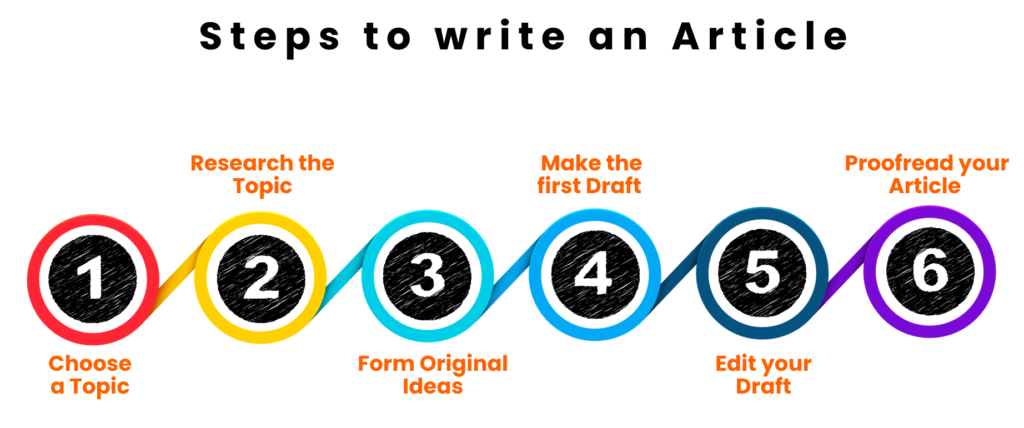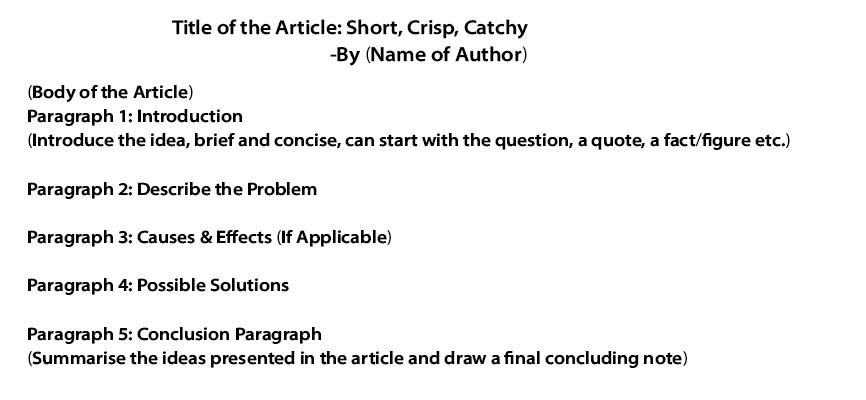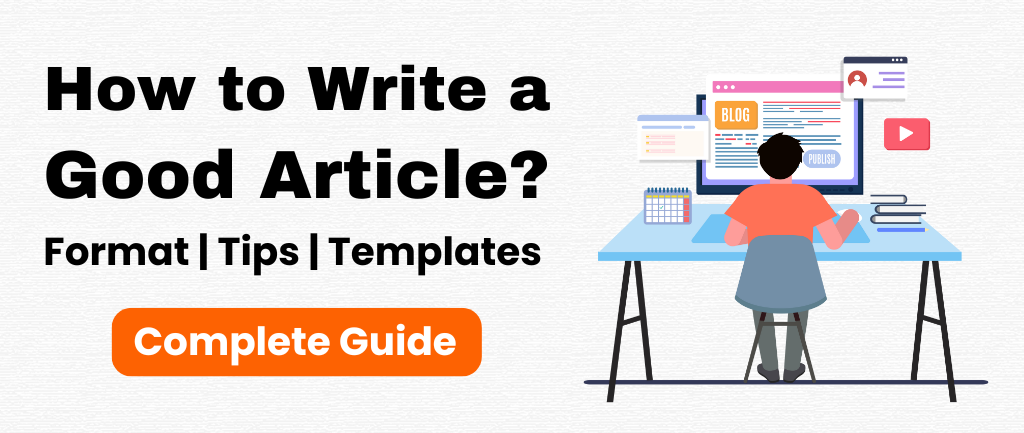Writing an article can be scary for many people, but it’s actually something you can get better at with a few simple steps and some practice. It’s not always easy, but you can improve your article writing by following a basic structure and getting used to writing regularly.
Here’s a detailed guide to help you write a good article. We’ll cover the format, tips to make your article unique and interesting, and provide a few templates for you to use.
Read all the way to the end to learn how you can improve your article writing skills with just a few simple steps.
What is an Article?
An article is a piece of writing that is written centred around a theme or topic and aimed at spreading awareness or communicating a message to the readers. The aim of writing an article can be varied-
- Spreading awareness about a recent incident
- Writing for promotion
- Spreading awareness about a social issue
- Sharing an Opinion about an issue
- Persuading the readers about a topic
- Writing an informative piece on a specific topic
No matter why you are writing an article, there are some basic things you need to know before you start writing.
Types of Articles
Before you write an article, it’s important to know the exact purpose. This will determine the tone, content, and style of your writing.

There are many types of articles, but they can be clubbed into 4 broad categories listed below:
| Type of Article | Major Features | Examples |
| Expository Article |
|
|
| Narrative Article |
|
|
| Descriptive Article |
|
|
| Argumentative & Persuasive Articles |
|
|
Steps for Writing an Article
Before you start writing an article, you should know and follow some basic steps. These steps will help you write more efficiently and produce better results.
Here are the basic steps for writing a good, catchy article.
– Choose your Topic
Before writing down a piece, this is the most fundamental aspect to know.
You must choose an appropriate topic based on your needs and the theme you want to write a piece on. If you already know the theme to write the topic, choose a topic which
- Can garner a larger audience, e.g. a recently trending topic, a topic with a huge demand or a topic in which people have many doubts and concerns (for descriptive or expository or commercial articles)
- Can create a strong impact on the reader’s mind (for editorials and opinion and argumentative articles)
- Is catchy and keeps the readers engaged in reading
- Is Niche-Specific
Choosing a topic is a step that deserves some time and thought. It’s best to pick a topic you already know a bit about and can share some original insights on.
Choosing the right topic is also important because it affects the style and tone of your writing.
– Know Your Topic
Research, research, research! The key to writing a good article is having a strong understanding of your chosen topic. This is especially important for topical, thematic, persuasive, argumentative, or descriptive articles.
After choosing your topic, it’s important to read and research it thoroughly. This helps you support your ideas with facts and figures and express your thoughts more clearly.
Start by learning the basics of the topic. Get familiar with the technical aspects, and gather relevant facts, figures, and findings to include in your article.
– Form Original Ideas
This is an important practice more than a step in the process. Whether you’re writing an article, a story, or an essay, it’s essential to develop your own understanding and original ideas about the topic.
If your article just repeats well-known facts without adding unique insights, it won’t impress readers or make an impact.
So, make sure to consciously work on developing your own ideas. This not only helps you create a unique and impactful piece but also reduces the risk of plagiarism, which is especially important for web or SEO writing.
– Knowing the Target Audience
Once you have chosen your topic and done some research, you will have a good idea of who your target audience is.
For any topic, there will be a group of readers you want to reach with your article.
It’s important to know your target audience well so you can make your article relevant to their needs and concerns. This is especially important for commercial, argumentative, persuasive, descriptive, or tutorial articles.
You can make a bigger impact on your readers if you understand your target group (TG) because you’ll be able to address their questions and concerns more effectively.
– Prepare an Outline
This is the first step in actually writing your article. After you’ve done your research and gained some understanding of the topic, you should create a rough outline before you start writing.
In this outline:
- List down all the basic ideas you want to include in your article
- Arrange the content in a cohesive manner- the introduction, the main ideas in the body, supporting facts and figures, causes and effects (if relevant to your topic), possible solutions in case the topic involves a problem and a conclusion
- Decide upon some additional information you wish to add in the article and then include them in your outline
The idea is to write down the main points from your research and ideas. Decide how to include them in your article. Making an outline before writing may seem like it takes extra time, but it actually saves time and helps you write a more organized article.
– Draft your First Copy of the Article
After completing the steps above, you can begin writing your article. Below are some basic tips to help you write effectively. Keep reading to learn more.
If you find that your writing isn’t as effective as you’d like it to be, don’t worry. It’s normal for the first draft to need adjustments. The key is to draft it first, then review and tweak it as needed to get the best results.
– Edit Your Piece
After finishing the first draft of your article, the next step is to carefully edit it. Here are some key ideas to keep in mind during the editing process:
- Look for Errors: Grammatical, Spelling, Factual (in case you have included them in your piece)
- Look for Irrelevant Content: too much irrelevant or extra information in your article makes it less engaging to read and may lead the reader to lose interest in it and give up before it ends.
- Analyse the Overall Structure of your Article: Check if your article is coherent and the thoughts and ideas have been articulated in a structured and sequentially logical manner or edit it accordingly.
– Proofread your Final Article
The final step to complete your article is to proofread the entire piece at once after you’ve finished editing. This helps you find any errors and evaluate the overall article.

By following these steps, you’re more likely to create an article that is well-structured and engaging for your readers.
Format of an Article
Articles have an easy-to-follow format, and regardless of their type or purpose, they generally follow the same basic structure.
An article format consists of 3 main parts:
- The Title of the Article: This appears on the top of the article and is centred. The title should be short, crisp and catchy, giving an idea about the topic of the article.
- The By Line (Name of Author): This line starts with ‘By (Name of Author)’ and is placed right below the title, with an indentation to the right
- The Body of the Article: This is the main part of the article that includes all the information and your writing, and consists of 5-6 paragraphs or more depending on the depth and extensiveness in which you want to cover the topic.
The body of the article further has 3 major parts:
- The Introduction Paragraph: This is the paragraph with which you begin your article. This introduces the topic or the problem to the readers, helping them form a basic first idea about the article. You can use
-
-
- Idioms
- Catchy Phrases
- Question or
- Interesting Fact or Figure
-
To begin your article, as they help to catch the attention of the readers and keep them hooked to your piece. The introductory paragraph should be brief, concise but should articulate the rest of the article well.
- The Body of the Article: This is the main component of your article and requires maximum attention. There is no fixed limit to the size of the body of your article, but usually, the body of the article can be broken down further into 3 to 4 paragraphs which can focus on these
-
-
- Description of the problem
- Causes of the problem/ Main Factors of the Problem
- Possible Solutions
-
- The Conclusion Paragraph: The conclusion paragraph of the article summarises all the ideas presented in the article to draw a final concluding note, as well as leave the readers with some final food for thought. You can conclude a thematic or opinion-based article at an open end or with your own conclusion. In case of expository articles, you can conclude by summarising all the information shared in the article.
Here we have provided you the basic format of an article:

Tips for Writing a Good Article
Here we have listed some of the tips to keep in mind while writing an article:
- The title of your article should be catchy and attractive as it hooks the readers to the article
- Try to begin with a relevant quote, an interesting or insightful fact/figure, a thought-provoking question or an idiom
- Be extra careful so as to avoid spelling, grammar and linguistic errors in your article.
- Keep the introduction paragraph brief and to-the-point, and make sure you introduce the topic well and in an engaging manner.
- While writing the body of the article, break it into paragraphs based on the different ideas or perspectives you are showing.
- Try to support your ideas with relevant facts, figures or research findings wherever possible, but DO NOT stuff your article with too many facts or figures.
- Keep the tone engaging, for example, you can end paragraphs with insightful or thought-provoking questions, especially for a persuasive or argumentative article.
- Use a simple and concise language to make your article more readable. Do not use too many jargons, flowery or difficult language as it may make the article tough to understand by the readers.
- Keep the target audience for your topic in mind, and ensure that you try to answer the relevant queries while writing your article, this makes your article more friendly for the internet and helps you generate greater traffic.
- Do not copy content from other sources. Always make sure you write in your own language. Plagiarised writing is highly frowned upon and can even lead to blacklisting or copyright issues.
- Use of personal examples, opinions or biases isn’t recommended in case of expository articles. You can use a few personal examples as well as subjective opinions in argumentative and persuasive articles as long as they are relevant to the topic of the article.
- If the topic chosen for your article is thematic or involves a social issue, you can suggest a few possible solutions to end your article on an optimistic note.
- Always write a good and insightful conclusion.
- Make the conclusion paragraph short, and summarise all the major arguments made in the article.
- You can end the conclusion paragraph on an open note or with a useful insight of your own.
Conclusion
If you’re planning to write an article in the future or right now, there’s no need to worry. You can improve your skills with practice and by keeping some basic steps in mind. The key to writing a good article is to work on your language and grammar skills and to practice writing regularly. Writing regularly helps you improve your ability to express your ideas effectively.

